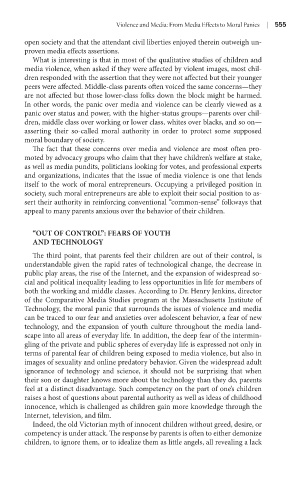Page 576 - Battleground The Media Volume 1 and 2
P. 576
V olence and Med a: From Med a Effects to Moral Pan cs |
open society and that the attendant civil liberties enjoyed therein outweigh un-
proven media effects assertions.
What is interesting is that in most of the qualitative studies of children and
media violence, when asked if they were affected by violent images, most chil-
dren responded with the assertion that they were not affected but their younger
peers were affected. Middle-class parents often voiced the same concerns—they
are not affected but those lower-class folks down the block might be harmed.
In other words, the panic over media and violence can be clearly viewed as a
panic over status and power, with the higher-status groups—parents over chil-
dren, middle class over working or lower class, whites over blacks, and so on—
asserting their so-called moral authority in order to protect some supposed
moral boundary of society.
The fact that these concerns over media and violence are most often pro-
moted by advocacy groups who claim that they have children’s welfare at stake,
as well as media pundits, politicians looking for votes, and professional experts
and organizations, indicates that the issue of media violence is one that lends
itself to the work of moral entrepreneurs. Occupying a privileged position in
society, such moral entrepreneurs are able to exploit their social position to as-
sert their authority in reinforcing conventional “common-sense” folkways that
appeal to many parents anxious over the behavior of their children.
“ouT oF ConTroL”: FEars oF youTh
anD TEChnoLogy
The third point, that parents feel their children are out of their control, is
understandable given the rapid rates of technological change, the decrease in
public play areas, the rise of the Internet, and the expansion of widespread so-
cial and political inequality leading to less opportunities in life for members of
both the working and middle classes. According to Dr. Henry Jenkins, director
of the Comparative Media Studies program at the Massachusetts Institute of
Technology, the moral panic that surrounds the issues of violence and media
can be traced to our fear and anxieties over adolescent behavior, a fear of new
technology, and the expansion of youth culture throughout the media land-
scape into all areas of everyday life. In addition, the deep fear of the intermin-
gling of the private and public spheres of everyday life is expressed not only in
terms of parental fear of children being exposed to media violence, but also in
images of sexuality and online predatory behavior. Given the widespread adult
ignorance of technology and science, it should not be surprising that when
their son or daughter knows more about the technology than they do, parents
feel at a distinct disadvantage. Such competency on the part of one’s children
raises a host of questions about parental authority as well as ideas of childhood
innocence, which is challenged as children gain more knowledge through the
Internet, television, and film.
Indeed, the old Victorian myth of innocent children without greed, desire, or
competency is under attack. The response by parents is often to either demonize
children, to ignore them, or to idealize them as little angels, all revealing a lack

